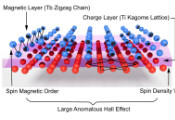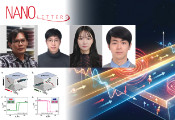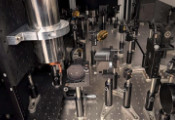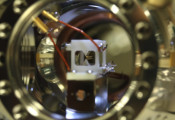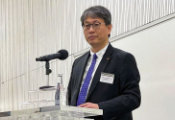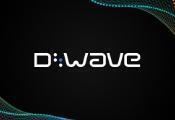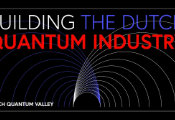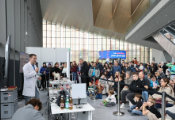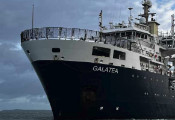‘Spooky Action’ at a Very Short Distance: Scientists Map Out Quantum Entanglement in Protons
UPTON, N.Y., December 02, 2024 -- Scientists at the U.S. Department of Energy’s (DOE) Brookhaven National Laboratory and collaborators have a new way to use data from high-energy particle smashups to peer inside protons. Their approach uses quantum information science to map out how particle tracks streaming from electron-proton collisions are influenced by quantum entanglement inside the proton.
The results reveal that quarks and gluons, the fundamental building blocks that make up a proton’s structure, are subject to so-called quantum entanglement. This quirky phenomenon, famously described by Albert Einstein as “spooky action at a distance,” holds that particles can know one another’s state — for example, their spin direction — even when they are separated by a great distance. In this case, entanglement occurs over incredibly short distances — less than one quadrillionth of a meter inside individual protons — and the sharing of information extends over the entire group of quarks and gluons in that proton.
The team’s latest paper, just published in the journal Reports on Progress in Physics (ROPP), summarizes the group’s six-year research effort. It maps out precisely how entanglement affects the distribution of stable particles that emerge at various angles from the particle smashups after quarks and gluons liberated in the collisions coalesce to form these new composite particles.
This new view of entanglement among quarks and gluons adds a layer of complexity to an evolving picture of protons’ inner structure. It may also offer insight into other areas of science where entanglement plays a role.
“Before we did this work, no one had looked at entanglement inside of a proton in experimental high-energy collision data,” said physicist Zhoudunming (Kong) Tu, a co-author on the paper and collaborator on this exploration since joining Brookhaven Lab in 2018. “For decades, we’ve had a traditional view of the proton as a collection of quarks and gluons and we’ve been focused on understanding so-called single-particle properties, including how quarks and gluons are distributed inside the proton.
“Now, with evidence that quarks and gluons are entangled, this picture has changed. We have a much more complicated, dynamic system,” he said. “This latest paper refines our understanding of how entanglement impacts proton structure.”
Mapping out the entanglement among quarks and gluons inside protons could offer insight into other complex questions in nuclear physics, including how being part of a larger nucleus affects proton properties. This will be one focus of future experiments at the Electron-Ion Collider (EIC), a nuclear physics research facility expected to open at Brookhaven Lab in the 2030s. The tools these scientists are developing will enable predictions for EIC experiments.
Deciphering messiness as a sign of entanglement
For this study, the scientists used the language and equations of quantum information science to predict how entanglement should impact particles streaming from electron-proton collisions. Such collisions are a common approach for probing proton structure, most recently at the Hadron-Electron Ring Accelerator (HERA) particle collider in Hamburg, Germany, from 1992 to 2007, and are planned for future EIC experiments.
This approach, published in 2017, was developed by Dmitri Kharzeev, a theorist affiliated with both Brookhaven Lab and Stony Brook University who is a co-author on the paper, and Eugene Levin of Tel Aviv University. The equations predict that if the quarks and gluons are entangled, that can be revealed from the collision’s entropy, or disorder.
“Think of a kid’s messy bedroom, with laundry and other things all over the place. In that disorganized room, the entropy is very high,” Tu said, contrasting it with the low-entropy situation of his extremely neat garage, where every tool is in its place.
According to the calculations, protons with maximally entangled quarks and gluons — a high degree of “entanglement entropy” — should produce a lot of particles with a “messy” distribution — a high degree of entropy.
“For a maximally entangled state of quarks and gluons, there is a simple relation that allows us to predict the entropy of particles produced in a high energy collision,” Kharzeev said. “In our paper, we tested this relation using experimental data.”
The scientists started by analyzing data from proton-proton collisions at Europe’s Large Hadron Collider, but they also wanted to look at the “cleaner” data produced by electron-proton collisions. Knowing it would be a while before the EIC turns on, Tu joined one of the HERA experiment collaborations, known as H1, which still has a crew of retired physicists meeting occasionally to discuss their experiment.
Tu worked with physicist Stefan Schmitt, the current co-spokesperson for H1 from the Deutsches Elektronen-Synchrotron (DESY), for three years to mine the old data. The pair cataloged detailed information from data recorded in 2006-2007, including how particle production and distributions varied and a wide range of other information about the collisions that produced these distributions. They published all the data for others to use.
When the physicists compared the HERA data with the entropy calculations, the results matched the predictions perfectly. These analyses, including the latest ROPP results on how particle distributions change at various angles from the collision point, provide strong evidence that quarks and gluons inside protons are maximally entangled.
The results and methods help to lay the groundwork for future experiments at the EIC.
Statistical behavior and emergent properties
The revelation of entanglement among quarks and gluons sheds light on the nature of their strong-force interactions, Kharzeev noted. It may offer additional insight into what keeps quarks and gluons confined within protons, which is one of the central questions in nuclear physics that will be explored at the EIC.
“Maximal entanglement inside the proton emerges as a consequence of strong interactions that produce a large number of quark-antiquark pairs and gluons,” he said.
Strong-force interactions — the exchange of one or more gluons among quarks — take place between individual particles. That may sound just like the simplest description of entanglement, where two individual particles can know about one another no matter how far apart they are. But entanglement, which is really an exchange of information, is a system-wide interaction.
“Entanglement doesn’t only happen between two particles but among all the particles,” Kharzeev said.
Now that scientists have a way of exploring this collective entanglement, the tools of quantum information science could make some problems in nuclear and particle physics easier to understand.
“Particle collisions can be extremely complex with many steps that influence the outcome,” Tu said. “But this study shows that some outcomes, like the entropy of the particles emerging, are determined by the entanglement within the protons before they collide. Entropy doesn’t ‘care’ about the complexity of all the in-between steps. So maybe we can use this approach to explore other complex nuclear physics phenomena without worrying about the details of what happens along the way.”
Thinking about the collective behavior of a whole system rather than individual particles is common in other areas of physics and even everyday life. For example, when you think about a pot of boiling water, you don’t really know about the vibrational motion of each individual water molecule. No single water molecule can burn you. It’s the statistical average of all the molecules vibrating — their collective combined behavior — that gives rise to the property of temperature and makes the water feel hot. In a similar way, understanding how one quark and gluon behave doesn’t immediately convey how a proton behaves as a whole.
“The physics perspective changes when you have so many particles together,” Tu said, noting that quantum information science is a tool to describe the statistical or emergent behavior of the whole system. “This approach may offer insight into how the entanglement of the particles leads to the group behavior,” Tu said.
Putting the model to use
Now that the scientists have confirmed and validated their model, they want to use it in new ways. For example, they want to learn how being in a nucleus affects the proton.
“To answer this question, we need to collide electrons not just with individual protons but with nuclei — the ions of the EIC,” Tu said. “It will be very helpful to use the same tools to see the entanglement in a proton embedded in a nucleus — to learn how it is impacted by the nuclear environment.”
Will putting a proton in the very busy nuclear environment surrounded by lots of other interacting protons and neutrons wash out the individual proton’s entanglement? Could this nuclear environment play a role in so-called quantum decoherence?
“Looking at entanglement in the nuclear environment will definitely tell us more about this quantum behavior — how it stays coherent or becomes decoherent — and learn more about how it connects to the traditional nuclear and particle physics phenomena that we are trying to solve,” Tu said.
“The impact of the nuclear environment on protons and neutrons is at the center of the EIC science,” said by Martin Hentschinski, a co-author on the paper from the Universidad de las Américas Puebla (UDLAP) in Mexico.
Co-author Krzysztof Kutak of the Polish Academy of Sciences added, “There are many other phenomena we want to use this tool to study to push our understanding of the structure of visible matter to a new frontier.”
This research was funded by the DOE Office of Science, the European Union’s Horizon 2020 research and innovation program, UDLAP Apoyos VAC 2024, and Brookhaven Lab’s Laboratory Directed Research and Development program.
Brookhaven National Laboratory is supported by the Office of Science of the U.S. Department of Energy. The Office of Science is the single largest supporter of basic research in the physical sciences in the United States and is working to address some of the most pressing challenges of our time.


